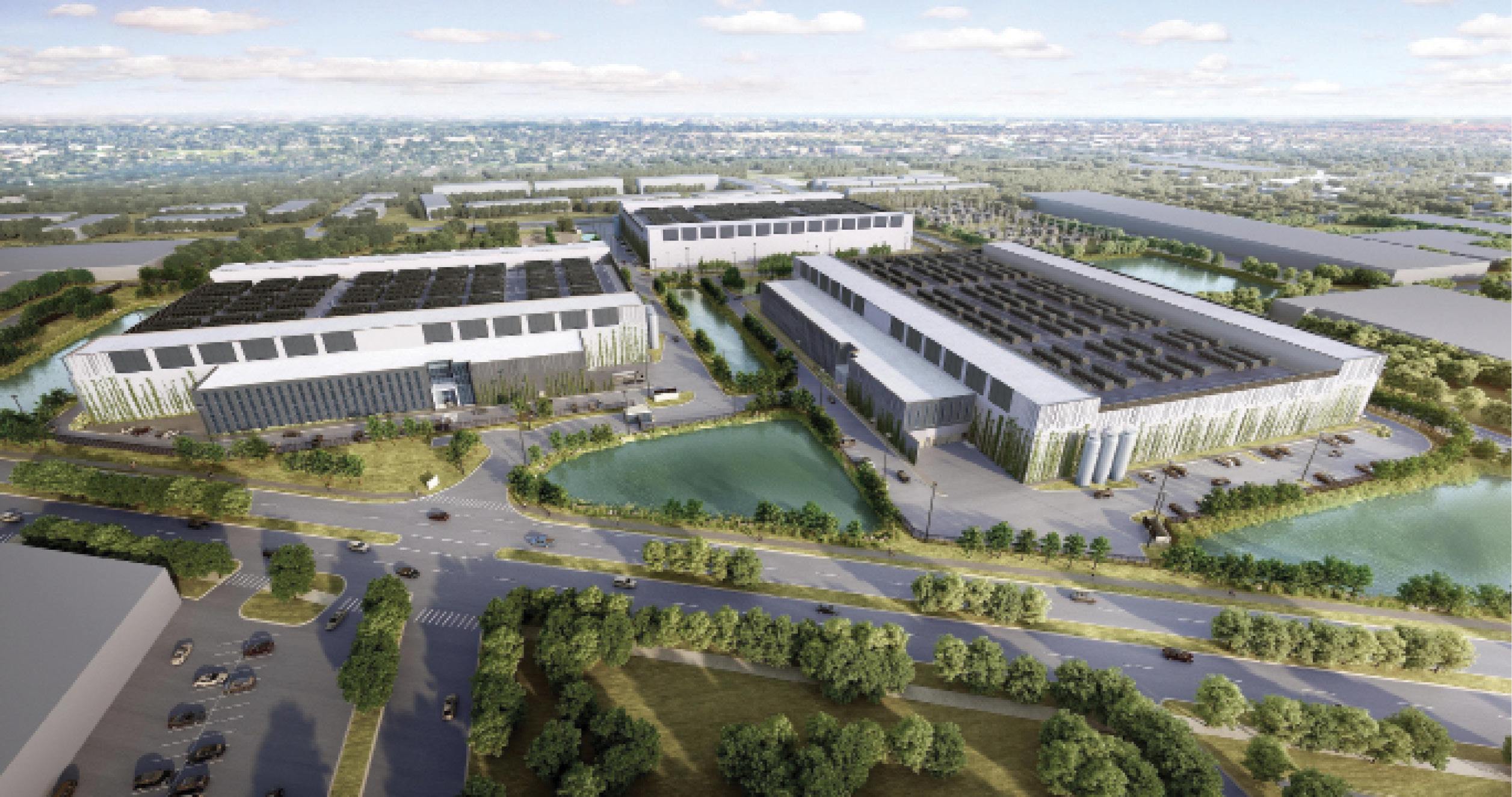Sometimes taking a step forward means borrowing a page from the past.
That’s exactly what Amazon is doing with its recently announced data center investment binge in Virginia. After announcing in January 2023 that it would invest $35 billion into new data center campuses across Virginia to expand its Amazon Web Services empire, the company billed as The Everything Store brought more clarity to this site search on September 4.
That’s when the Seattle-based e-commerce giant announced it would commit $11 billion to establish two data center campuses in Louisa County, about midway between Richmond and Charlottesville in east central Virginia.
Historically, the bulk of new data center development in the Old Dominion has gone to Northern Virginia locations like Loudoun County or Prince William County. In fact, Northern Virginia, at almost 2 gigawatts, is roughly three times the size of the next largest data center market in the world. Approximately half of all built data center space in the country is in Northern Virginia, according to CBRE.
But nothing lasts forever, and Amazon knows that. That’s why the Jeff Bezos-owned company is taking a page from history and selecting the land of Thomas Jefferson for a bold rush to the future. In the shadows of Charlottesville, Monticello and the University of Virginia, the $1.3 trillion firm will embark on one of the most ambitious tech projects in U.S. history.
“I worked on that Virginia project,” says Roger Wehner, economic development director for AWS. “Northern Virginia is a huge beneficiary of the network of infrastructure there. We developed a very strong partnership with Virginia, and we looked to go ever more rural in Virginia. The Louisa County announcement is emblematic of that growth.”
“Pay attention to companies that are willing to take a risk and buy the land and acquire the most power.”
— Andy Cvengros, Managing Director & Senior Vice President, JLL
When I asked Wehner why AWS selected Louisa County, he said, “Our site selection methodology is quite complex and rigorous. We choose locations based on electricity availability; access to renewable power; redundant power; stability of the grid; proximity to an existing cluster of similar projects; and a welcoming community. Virginia has been super welcoming to have us there.”
Experts who track data center expansion for a living say that projects like this one will become more common as new trends take shape. “We are absolutely seeing a migration to places where power is available,” says Pat Lynch, executive managing director of advisory and transaction for the Data Center Solutions Group at CBRE. “Instead of bringing power to the site, we are now bringing sites to the power. That is why Louisa County is being chosen, and that is why you are going to see places like Indianapolis and St. Louis selected for new data centers.”
Cindy King, community engagement manager for Louisa County government, confirmed to Site Selection that Amazon has selected two sites in the Technology Overlay District in the county. “The TOD areas were selected for their access to transmission lines, adequate road networks and sizeable acreage, in addition to other conditions that allow us to protect the rural character of Louisa County and minimize the impact on our resident,” say King. “We intended the TOD to be attractive to technology companies in that our approach provided parameters upfront and identified the best possible sites.”
The two campuses will be the first large data centers of their kind in Louisa County, says King. Recruiting them was intentional, she adds. “Our Board of Supervisors looks for projects that will diversify the tax base but will not require expanding essential services,” she says. “This approach makes data centers a target industry.” The twin projects are expected to bring several hundred new jobs to the area, she notes.
Banking Big on the Buckeye State
This is not the only big win for Virginia. Barely a week after announcing the Louisa County projects, Amazon filed for permits to build a two-building data center campus on 50 acres in Stafford County, about halfway between Richmond and Washington, D.C. Amazon plans to invest $1 billion to construct 510,000 sq. ft. in what it calls the Potomac Church Tech Center.
 All of these projects are part of Amazon’s massive buildout across the Old Dominion. In addition to its ongoing headquarters development in Arlington, Amazon continues to expand its AWS empire in Loudoun, Fairfax and Prince William Counties. Reportedly, AWS is also eyeing new data center sites in Caroline, Culpepper, Fauquier, King George and Spotsylvania Counties.
All of these projects are part of Amazon’s massive buildout across the Old Dominion. In addition to its ongoing headquarters development in Arlington, Amazon continues to expand its AWS empire in Loudoun, Fairfax and Prince William Counties. Reportedly, AWS is also eyeing new data center sites in Caroline, Culpepper, Fauquier, King George and Spotsylvania Counties.
Lynch says we should get used to this new reality. “What we’re seeing is not so much new markets but further investment into places that have room to grow,” he says. “Places like Charlotte, Raleigh, Omaha, Nebraska and Reno, Nevada, are all seeing large-scale data center development. Another one is Columbus, Ohio. Land costs there are a lot more affordable than what you will find in places like Ashburn, Virginia, Chicago, New York, Dallas, San Francisco and Atlanta. The Columbus-New Albany area in Central Ohio is hot right now.”
On June 26, 2023, state leaders in Ohio announced that Amazon’s highly profitable cloud computing business would invest $7.8 billion by the end of 2029 to expand its AWS data center operations in Central Ohio.
“For data centers, this kind of migration to interior locations of the country is not new,” says Lynch. “Look at Cheyenne, Wyoming. Plenty of data centers have been locating to lower-cost, safe environments for the past decade. Part of that is to serve the hyperscale computing users and the large enterprise users.”
Gordon Dolven, director of Americas data center research for CBRE, says that whether the user is Amazon, Meta, Google or Microsoft, “everyone is optimizing their data center footprint. Historically, they may have wanted to be in latency markets. But some of the storage files don’t need to be in the most expensive real estate space in the world. We are seeing smarter and smarter optimization of workloads as AI [artificial intelligence] takes hold. West Des Moines, Iowa, is a good example. They have planted a flag to build an AI-machine learning supercomputing center there.”
All of these trends are driving data center construction to record levels across the U.S. According to a report by CBRE in September, construction of data center space across the country in the first half of 2023 increased year-over-year by 25% to a record-high capacity of 2,288 megawatts.
Northern Virginia continues to lead the country with 918 megawatts of capacity under construction in the first half of the year, according to CBRE. The next five busiest markets in North America were Dallas-Fort Worth; Hillsboro, Oregon; Atlanta; Chicago and Phoenix. Rounding out the top eight were Silicon Valley and New York.
Want to Build? Get in Line
Lead times to complete construction were longer than ever, CBRE noted, as rising costs, labor shortages and limited available power made it harder to finish the work.
“Land acquisition, permitting, design, construction, water, connectivity, generators and power are the main elements needed to build a data center,” the CBRE Americas Research Report states. “Average construction timelines ranged between one and three years from 2015 to 2020. … Today, power availability is more constrained, extending construction timelines by two to four years and in some cases by as many as six years.”
What does all this mean? Electricity is the new gold. “Emerging data center markets like Omaha are seeing increased construction from hyperscalers,” the CBRE report notes. “Helping to sustain this growth, Omaha Public Power District recently approved a $2 billion plan to nearly double its generating capacity over the next decade.”
Markets that wish to compete for the biggest projects must find a way to offer reliable, competitively priced power. As CBRE states, “Looking ahead, it’s uncertain how long these extended construction timelines will persist. But it’s clear that reducing them will depend on finding ways to alleviate power infrastructure bottlenecks and supply chain delays.”
Andy Cvengros, managing director of brokerage and senior vice president in technology services at JLL, put it this way: “Getting transformers on site is key. Demand for that is two years out and longer. A lot of lead times for core power are three to seven years now. Pay attention to companies that are willing to take a risk and buy the land and acquire the most power.”
For now, Cvengros says he’s bullish on growth in Columbus, Phoenix, Salt Lake City, Reno and Austin. In Greater Chicago, he likes Aurora and Hoffman Estates.
“Primary markets will continue to expand outward,” he says. “You’re going to see buy-and-tear-down take place, particularly as some of the older facilities become obsolete. You will even see some office conversions to data centers.”
In the Spotlight: Clean Energy
 Jacob Albers, head of alternative insights for Cushman & Wakefield, says the push to go green is accelerating among data center operators. “Many operators and cloud providers who build their own data centers are looking to source hydroelectric power, solar and wind from nearby power generators,” he says. “We’re seeing this more in the Midwest, Texas and the Southwest. Some of the major cloud providers are building either onsite or adjacent to the campus their own dedicated solar and wind farms to power the campus.”
Jacob Albers, head of alternative insights for Cushman & Wakefield, says the push to go green is accelerating among data center operators. “Many operators and cloud providers who build their own data centers are looking to source hydroelectric power, solar and wind from nearby power generators,” he says. “We’re seeing this more in the Midwest, Texas and the Southwest. Some of the major cloud providers are building either onsite or adjacent to the campus their own dedicated solar and wind farms to power the campus.”
Albers adds that the surge in AI is also affecting the layout and design of data centers. “The requirements for things like cooling and demand for water are huge. Can you get sufficient power, connectivity and water to the site to serve the needs of your data center? These are questions being asked,” he says. “Some Southwest states have passed restrictions on water cooling. As AI-powered data centers expand, this will affect where they can be built.”
In other words, the future of data centers will not be business as usual.

